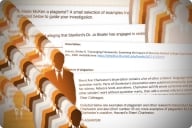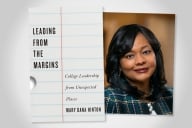You have /5 articles left.
Sign up for a free account or log in.
Could public colleges be free?
Yes, says the head of the union for University of California’s 4,000 instructors and librarians.
How?
Trim non-essential functions, redirect a bunch of money and end tax breaks that mostly benefit wealthy college-goers’ families, argues University Council-American Federation of Teachers President Bob Samuels. Of course, not everyone would agree with his definition of non-essential, particularly researchers.
Samuels’ new book says students have become “slaves to debt” because colleges have decided to get into “expensive and disorienting” endeavors – research labs funded by external dollars, luxury dorms and athletics – that have little to do with instructing students. He says American higher education costs more than it should and undergraduates are forced to pick up the tab for university mission creep. On top of that, undergrads are suffering through large, impersonal classes and left in the hands of graduate students. While Samuels wants all of public higher education to be free, many of his examples of spending cuts are generally found at research universities with big-time athletics and don't exist at, say, community colleges, which already charge bare-bones rates.
The book, Why Public Higher Education Should Be Free: How to Decrease Costs and Increase Quality at American Universities (Rutgers University Press), offers a relatively simple if audacious proposal: redirect government higher ed spending so some 11 million students can attend public two and four-year institutions free of charge. That's the “decrease costs” part.
To “increase quality,” trim costs for athletics and pricey administrators and star professors who don’t teach much anyway. Use the savings to reduce class sizes and hire qualified instructors who can spend time with students.
Samuels estimates that full-time undergraduate tuition, room and board and other expenses at public four-year institutions and community colleges costs about $130 billion a year. Then, Samuels estimates that the state and federal governments could come up with $180 billion a year by better using the money they already pay to public colleges and redirecting the money they spend on student aid and lose to higher ed-related tax breaks for parents and students with mostly wealthy backgrounds. (NOTE: This pararagraph has been updated to correct the subject of the $130 million figure.")
"The tax code has been used to fund higher education because it is easier for Congress to pass a tax break than it is to get funding for a particular program," Samuels writes, "but what this system has achieved is a tremendous subsidy for upper-middle-class and wealthy families, while lower-income students are forced to take out huge loans to pay for their education."
In the process, Samuels’s plan would scale back corporate and other external research funding across the board and financial aid to students at private and for-profit colleges, although he said in an interview that about $50 billion left over could be used to cover things like that.
Samuels said a systemic shakeup is necessary to avoid the “giant social and economic catastrophe” that will come if students who attend college are forever crushed by debt from ever-rising costs or left with poor educations.
In an interview, he said the book evolved as he began to look at numbers.
“I totally did not start off the book thinking I was going to make this call for public higher education, and I was really surprised that we have more than enough money to make it free,” Samuels said. “The major stumbling block is people no longer believe in large government programs.”
Indeed, the latest major federal government program, President Obama’s health care plan, is deeply controversial.
But Samuels sees a lot of parallels between the American higher education system and the American health care system. Namely, “we spend more and the quality is less,” Samuels said.
Patrick Callan, president of the National Center for Public Policy and Higher Education, doesn't agree with all of Samuels' ideas, but said he is “bold and courageous” for attempting to do more than just nip and tuck a broken system.
Even if what Samuels proposes never comes to pass, Callan said, the country needs to have a discussion about higher ed that goes beyond just student loan interest rates or the sort of tweaks to financial aid and college rankings that Obama proposed last week. Those plans may be more feasible, but they don’t do nearly enough to reduce the stratification of American higher ed, he said.
“The trouble is that most of the things that are politically realistic don’t get us where we need to go, so we need to reframe,” Callan said.
Samuels’s book takes on pretty much every major higher ed issue of the day, from administrative bloat to the hidden costs of campus technology.
But his core argument is that universities are no longer focused on educating students, particularly undergrads. Undergrads are the ones who are subsidizing everything else that happens at a university, he writes.
"Undergraduate students and their parents are therefore paying for the replacement of teaching with external research and administration, and what makes this situation even more upsetting is the fact that these institutions still claim that their central mission is education," he writes.
Instead of doing what’s best for undergrads, Samuels writes, administrators are pulling qualified professors and instructors out of undergraduate classrooms and sticking students in large classes or leaving them in the hands of unqualified graduate students.
Undergraduates don’t complain because “universities spend a great deal of money pleasing them outside the classroom,” Samuels writes, a reference to college sports and well-appointed living quarters and campus facilities.
Samuels writes that universities need to scale back their research mission, though he said he does not oppose basic and departmental research, and he writes faculty need to stop surrendering control of their classes to graduate students. External research is subsidized by taxpayers and students, he writes..
"Given that the most expensive aspect of developing new products is the research and design stage, universities offer a relatively cheap way of designing and testing new technologies for major corporations and government programs," Samuels writes. "In this system, state and student funds are used to build expensive labs and pay the salaries of professors and graduate students; companies basically rent the use of these workers and labs at a very low price."
Change the system, Samuels said and public college can be free.
“We already have enough money in the system to eliminate the cost of tuition or related student cost, if we just use the money we currently use in a more efficient manner, which includes tax breaks, federal aid, state aid,” Samuels said. “We could avoid students' taking on tremendous debt.”








